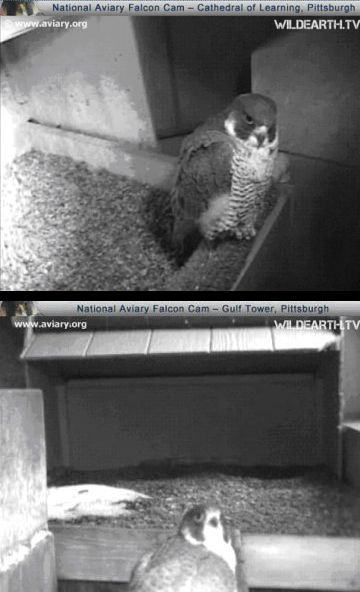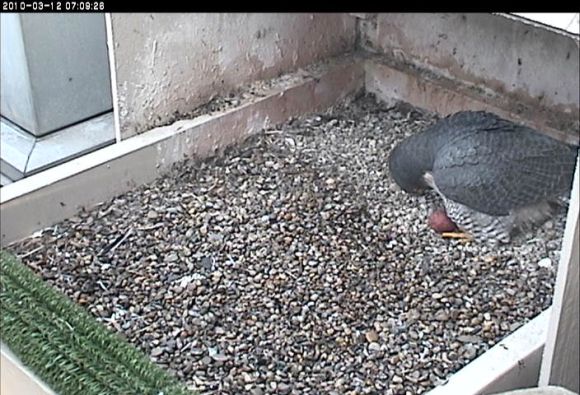 Pittsburgh’s peregrines will soon lay eggs. I know this because the females won’t sleep at the nest until they’re a week or two away from their first egg – and here they are last night.
Pittsburgh’s peregrines will soon lay eggs. I know this because the females won’t sleep at the nest until they’re a week or two away from their first egg – and here they are last night.
Pictured at left is Dorothy at the University of Pittsburgh before dawn this morning, illuminated by the webcam’s infrared light. She was sleeping on her perch and woke to preen just as twilight began. As the sky got brighter she called to rouse her mate, E2. Twenty minutes later she left the perch even though it was still dark. Perhaps she saw him fly away to get her breakfast.
Meanwhile, before dawn at the Gulf Tower, Tasha was puttering on the ramp in front of the nestbox when she heard her mate call to her. She replied with faint “ee-chups” and Louie called again. Soon she walked up the ramp and waited in the nest scrape at the back of the box. She was waiting for breakfast.
As female peregrines approach egg laying time, their mates provide their food. For the males this is a heavy responsibility that comes at the same moment when they must defend their territories against intruders. Only a strong male peregrine can fulfill all these tasks — and this is only the start. When the eggs hatch he provides food for the entire family until the chicks are beyond the brooding stage.
You, too, can see and hear Pittsburgh’s peregrines at their nests. Click here for the Cathedral of Learning webcam and here for the Gulf Tower webcam. Because there are infrared lights, you can watch them both night and day.
(photos from the National Aviary peregrine webcams at the Cathedral of Learning and the Gulf Tower)
p.s. If your computer can’t stream, watch the snapshot camera at Pitt that refreshes every 15 seconds.
 Dorothy laid her second egg this morning at 11:52am (Daylight Savings Time). Nora, who posts on the CMNH Falcon Forums, captured the first photos of it. Here you can clearly see both eggs just minutes after the second one was laid.
Dorothy laid her second egg this morning at 11:52am (Daylight Savings Time). Nora, who posts on the CMNH Falcon Forums, captured the first photos of it. Here you can clearly see both eggs just minutes after the second one was laid.
 Dorothy’s egg pre-empted my normal Friday anatomy lesson. Now that the first excitement is over, I can resume our regular programming (as we say in the TV business) with a bird anatomy lesson you can apply right away.
Dorothy’s egg pre-empted my normal Friday anatomy lesson. Now that the first excitement is over, I can resume our regular programming (as we say in the TV business) with a bird anatomy lesson you can apply right away. 





